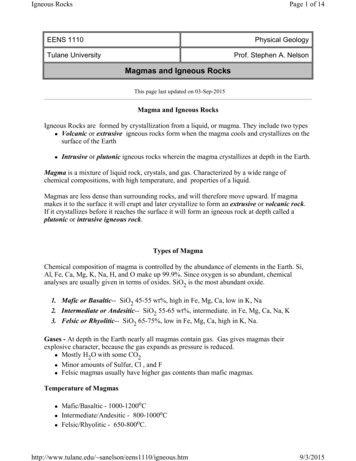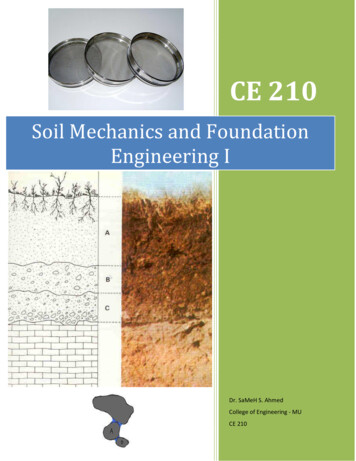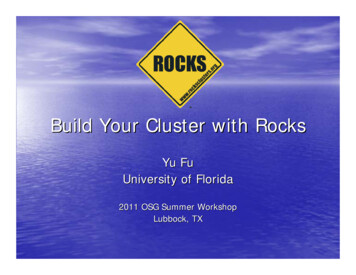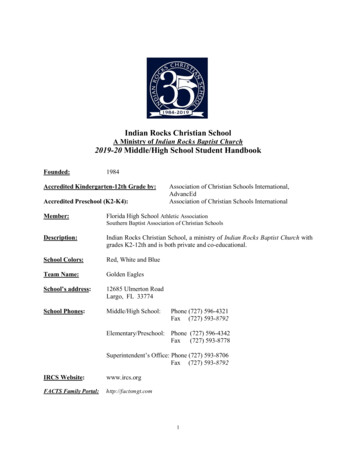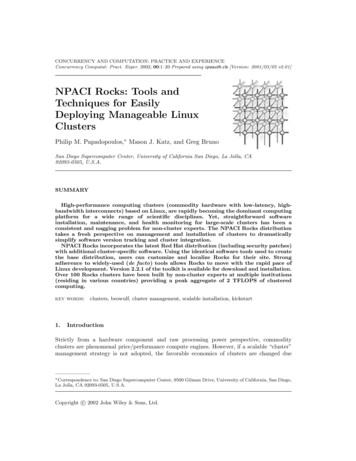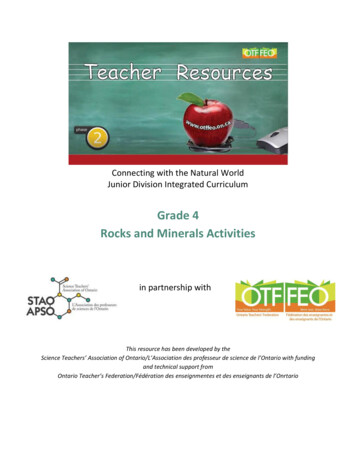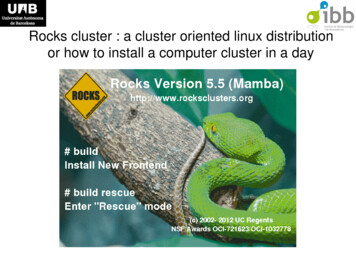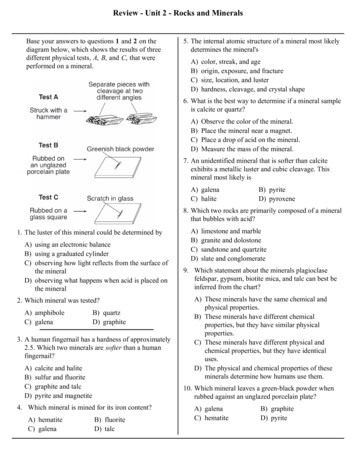
Transcription
Review - Unit 2 - Rocks and MineralsBase your answers to questions 1 and 2 on thediagram below, which shows the results of threedifferent physical tests, A, B, and C, that wereperformed on a mineral.5. The internal atomic structure of a mineral most likelydetermines the mineral'sA)B)C)D)color, streak, and ageorigin, exposure, and fracturesize, location, and lusterhardness, cleavage, and crystal shape6. What is the best way to determine if a mineral sampleis calcite or quartz?A)B)C)D)Observe the color of the mineral.Place the mineral near a magnet.Place a drop of acid on the mineral.Measure the mass of the mineral.7. An unidentified mineral that is softer than calciteexhibits a metallic luster and cubic cleavage. Thismineral most likely isA) galenaC) haliteB) pyriteD) pyroxene8. Which two rocks are primarily composed of a mineralthat bubbles with acid?1. The luster of this mineral could be determined byA) using an electronic balanceB) using a graduated cylinderC) observing how light reflects from the surface ofthe mineralD) observing what happens when acid is placed onthe mineral2. Which mineral was tested?A) amphiboleC) galenaB) quartzD) graphite3. A human fingernail has a hardness of approximately2.5. Which two minerals are softer than a humanfingernail?A)B)C)D)calcite and halitesulfur and fluoritegraphite and talcpyrite and magnetitelimestone and marblegranite and dolostonesandstone and quartziteslate and conglomerate9. Which statement about the minerals plagioclasefeldspar, gypsum, biotite mica, and talc can best beinferred from the chart?A) These minerals have the same chemical andphysical properties.B) These minerals have different chemicalproperties, but they have similar physicalproperties.C) These minerals have different physical andchemical properties, but they have identicaluses.D) The physical and chemical properties of theseminerals determine how humans use them.10. Which mineral leaves a green-black powder whenrubbed against an unglazed porcelain plate?4. Which mineral is mined for its iron content?A) hematiteC) galenaA)B)C)D)B) fluoriteD) talcA) galenaC) hematiteB) graphiteD) pyrite
Base your answers to questions 11and 12on the diagram below, which shows three minerals with threedifferent physical tests, A, B, and C, being performed on them.11.The results of all three physical tests shown are most useful for determining theA)B)C)D)rate of weathering of the mineralsidentity of the mineralsenvironment where the minerals formedgeologic period when the minerals formed12.Which sequence correctly matches each test, A, B, and C, with the mineral property tested?A) A—cleavage; B—streak; C—hardnessC) A—streak; B—cleavage; C—hardnessB) A—cleavage; B—hardness; C—streakD) A—streak; B—hardness; C—cleavage13. Which mineral is white or colorless, has a hardnessof 2.5, and splits with cubic cleavage?A) calciteC) pyriteB) haliteD) mica14. Which property is most useful in mineralidentification?A) hardnessC) sizeB) colorD) texture15. Which mineral property is illustrated by the peelingof muscovite mica into thin, flat sheets?A) lusterC) hardnessB) streakD) cleavage16. Silicate minerals contain the elements silicon andoxygen. Which list contains only silicate materials?A)B)C)D)graphite, talc, and selenite gypsumpotassium feldspar, quartz, and amphibolecalcite, dolomite, and pyroxenebiotite mica, fluorite, and garnet
17. Base your answer to the following question on thedata table below.22. The diagrams below show the crystal shapes of twominerals.Quartz and halite have different crystal shapesprimarily becauseMoh's scale arranges minerals according to theirrelativeA)B)C)D)resistance to breakingresistance to scratchingspecific heatspecific gravityA)B)C)D)light reflects from crystal surfacesenergy is released during crystallizationof impurities that produce surface variationsof the internal arrangement of the atoms23. The diagram below shows a broken crystal of themineral halite18. How are the minerals biotite mica and muscovitemica different?A) Biotite mica is colorless, but muscovite mica isnot.B) Biotite mica contains iron and/or magnesium,but muscovite mica does not.C) Muscovite mica scratches quartz, but biotitemica does not.D) Muscovite mica cleaves into thin sheets, butbiotite mica does not.19. Which of the following elements is not found inPlagioclase Feldspar?A) NaB) AlC) SiD) Pb20. Which of the following show cleavage in 2directions at 90%?A) PyriteC) GarnetB) PyroxeneD) Fluorite21. Which rock is sedimentary in origin and formed as aresult of chemical processes?A) graniteC) brecciaB) shaleD) dolostoneThe shape of the halite crystal is a direct result of theA)B)C)D)internal arrangement of the atoms in the crystalemperature at which the crystal formedtype of surface on which the crystal formedstream erosion that changed the crystal24. Most sandstone bedrock is composed of sedimentthat wasA)B)C)D)sorted by size and not layeredsorted by size and layeredunsorted and not layeredunsorted and layered25. Which process led to the formation of thick saltdeposits found in the bedrock at some locations inNew York State?A) meltingC) condensationB) runoffD) evaporation
26. Base your answer to the following question onthe two tables below and on your knowledge of Earth science. Table 1 shows the composition,hardness, and average density of four minerals often used as gemstones. Table 2 lists the minerals inMoh's Scale of Hardness from 1 (softest) to 10 (hardest).The hardness and density of each gemstone is based primarily on the gemstone’sA) internal arrangement of atomsC) oxygen contentB) geologic time of formationD) natural abundance27. Base your answer to the following question on the block diagram below, which shows a portion ofEath's crust. Letters A, B, C, and D indicate sedimentary layers.Which processes produced rock layer B?A) subduction and meltingC) heat and pressureB) uplift and solidificationD) compaction and cementation28. Particles of sediment collected from a lake bottomaveraged 1.2 centimeters in diameter. If left on thelake bottom to become buried by more sediment andcompressed into rock, these particles would formA) sandstoneC) quartziteB) conglomerateD) granite29. A rock is composed of several large, roundedpebbles and sand grains cemented together. Whichinference about the rock is best supported by thisdescription?A)B)C)D)The rock is older than the pebbles.The rock is igneous.The rock is sedimentary.The rock resulted from evaporation of seawater.
30. Base your answer to the following question on the diagram below, which represents a cross section ofrock layers that have not been overturned.Within which rock type would a fossil most likely be found?A)B)C)31. Base your answer to the following question on thediagram below, which represents a rock samplecontaining fossilized Coelophysis footprints.D)33. The diagram below shows three stages in theformation of a specific rock.The siltstone layer containing the dinosaur footprintswas turned into rock byA)B)C)D)folding and faultingburial and cementationweathering and erosiondeformation and melting32. Which process most likely formed a layer of thesedimentary rock, gypsum?A)B)C)D)precipitation from seawatersolidification of magmafolding of clay-sized particlesmelting of sand-sized particlesWhich rock is formed as a result of these threestages?A) limestoneC) schistB) gneissD) coal34. Which rock most likely formed as a result ofbiologic processes?A) graniteC) sandstoneB) basaltD) limestone35. Which texture best describes an igneous rock thatformed deep underground?A) glassyC) fine grainedB) vesicularD) coarse grained
36. Which processes lead directly to the formation ofigneous rock?A)B)C)D)weathering and erosioncompaction and cementationheat and pressuremelting and solidification43. The best evidence for determining the cooling rate ofan igneous rock during its solidification is providedbyA)B)C)D)index fossilsfaults in the rockthe crystal size of its mineralsthe disintegration of radioactive substancesC)D)37. What is the color and type of rock that forms oceaniccrust at mid-ocean ridges?44. Which graph best represents the relationshipbetween the length of time molten magma takes toA) light colored and igneouscool and the size of the crystals in the rock formedB) light colored and sedimentaryby the magma?C) dark colored and igneousA)B)D) dark colored and sedimentary38. Which igneous rock is dark colored, cooled rapidlyon Earth's surface, and is composed mainly ofplagioclase feldspar, olivine, and pyroxene?A) obsidianC) gabbroB) rhyoliteD) scoria39. Which igneous rock has a vesicular texture andcontains the minerals potassium feldspar and quartz?A) andesiteC) pumiceB) pegmatiteD) scoria40. Which is the best description of the properties ofbasalt?A)B)C)D)fine-grained and maficfine-grained and felsiccoarse-grained and maficcoarse-grained and felsic41. Which granite sample most likely formed frommagma that cooled and solidified at the slowest rate?A)B)C)D)42. Which rock is only formed by regionalmetamorphism?A) slateC) duniteB) hornfelsD) marble45. The rock shown below has a foliated texture andcontains the minerals amphibole, quartz, andfeldspar arranged in coarse-grained bands.Which rock is shown?A) slateC) gneissB) duniteD) quartzite46. Which rock is foliated, shows mineral alignment butnot banding, and contains medium-sized grains ofquartz and pyroxene?A) phylliteC) gneissB) schistD) quartzite47. Which two kinds of adjoining bedrock would mostlikely have a zone of contact metamorphismbetween them?A)B)C)D)shale and conglomerateshale and sandstonelimestone and sandstonelimestone and granite
48. Which graph best shows the relationship between the compositions of different igneous rocks andtheir densities?A)B)C)D)49. The data table below lists characteristics of rocks A, B, C, and D.Which rock is most likely phyllite?A) AB) BC) C50. Which sequence of change in rock type occurs asshale is subjected to increasing heat and eslateschistgneissphylliteschistslate51. Rocks are classified as igneous, sedimentary, ormetamorphic based primarily on theirA)B)C)D)texturecrystal or grain sizemethod of formationmineral compositionD) D52. Which characteristic of an igneous rock wouldprovide the most information about the environmentin which the rock solidified?A) colorC) hardnessB) textureD) streak53. Which characteristic of nonsedimentary rocks wouldprovide the least evidence about the environment inwhich the rocks were formed?A)B)C)D)structurecolorcrystal sizemineral composition
54. Base your answer to the following question on the cross section below. Rock units are labeled 1through 8. The line between A and A' indicates an unconformity.Which rock most probably formed in the contact metamorphic zone within rock unit 6?A) marbleB) basaltC) quartziteD) hornfels55. Base your answer to the following question on the geologic cross section below. Location A is withinthe metamorphic rock.The metamorphic rock at location A is most likelyA) marbleB) quartziteC) phylliteD) slate
56. How would the age of sandstone fragments found ina conglomerate rock compare with the age of theconglomerate rock?A) The sandstone fragments are younger than theconglomerate rock.B) The sandstone fragments are older than theconglomerate rock.C) The sandstone fragments and the conglomeraterock are the same age.D) The sandstone fragments may be either youngeror older than the conglomerate rock.57. Which type(s) of rock can be the source of depositedsediments?A)B)C)D)igneous and metamorphic rocks, onlymetamorphic and sedimentary rocks, onlysedimentary rocks, onlyigneous, metamorphic, and sedimentary rocks58. Metamorphic rocks form as the direct result ofA)B)C)D)precipitation from evaporating watermelting and solidification in magmaerosion and deposition of soil particlesheat and pressure causing changes in existingrock
Answer KeyReview - Rocks and 8.B29.C30.D31.B32.A33.D34.D35.D
different physical tests, A, B, and C, that were performed on a mineral. A)using an electronic balance B)using a graduated cylinder C)observing how light reflects from the surface of the mineral D)observing what happens when acid is placed on the mineral 1.The luster of this mineral could be determined by A)amphibole B)quartz C)galena D)graphite
